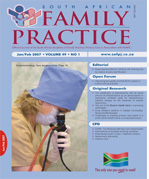The Use Of The Road To Health Card In Monitoring Child Health
Keywords:
child health, road to health card, growth faltering, immunisation coverage
Abstract
Objectives: The Road to Health Chart (RTHC) provides a simple, cheap, practical and convenient method of monitoring child health. The RTHC could assist with vaccine compliance and early identification of growth faltering, to improve general health. The purpose of the study was to assess whether the RTHCs were adequately completed and interpreted at primary, secondary and tertiary care levels in South Africa. Methods: The study was carried out at a primary, secondary and tertiary care centre. A questionnaire was administered to 100 subjects from each; seeking demographic information, whether the RTHC was brought along, and if not why it was not brought. Results: Most children were brought by their mothers. The RTHC was not brought to 48% of the consultations; of those, about 72% thought that bringing the RTHC along was not necessary. Health workers seldom asked to see the RTHC at the primary and secondary care settings, but 50% of them did so at Ga-Rankuwa Hospital (p = 0,002). In only 8 cases overall were the children below the 3rd percentile of weight-for-age. Approximately 20% had incomplete immunisations. Conclusions: Many parents believe that the RTHC is only required for Well-baby-clinic visits, not for consultations. The RTHC is not often asked for at consultations; the fact that this is more often done at the tertiary care centre may be that much of the service is supplied by paediatricians-in-training. Health workers should ask to see the RTHC, in order for mothers to understand the importance of the information. The study showed that the RTHC is not used to its full potential.
Published
2007-01-22
Section
Original Research
By submitting manuscripts to SAFP, authors of original articles are assigning copyright to the South African Academy of Family Physicians. Copyright of review articles are assigned to the Publisher, Medpharm Publications (Pty) Ltd, unless otherwise specified. Authors may use their own work after publication without written permission, provided they acknowledge the original source. Individuals and academic institutions may freely copy and distribute articles published in SAFP for educational and research purposes without obtaining permission.

